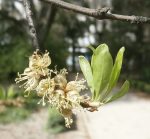 Desert olive, also known as stretchberry, elbowbush, spring goldengrow, Texas forsythia, and downy forestier, is a thicket-forming deciduous shrub or small tree is native to desert slopes, canyons, woodland edges and openings, pastures, meadows, prairies, and flats from Colorado and Utah south to Texas and California. It is a member of the olive family, Oleaceae, that also includes jasmine, lilac, privet, and forsythia. Arched branches with smooth chalky gray bark have spiny branchlets and light-green oval leathery leaves that turn yellow in fall. Small inconspicuous male and female flowers appear in clusters on different plants from late winter to spring before the leaves appear. They are greenish yellow, lack petals, and are fragrant. Female flowers give way to clusters of tiny blue-black fruits that are attractive to birds and mammals. Plants are host to hairstreak larva, while the flowers attract butterflies, bees, and other insects. Desert olive is adaptable and tolerates dry or moist soil as well as sun or shade. It is useful for native plant, meadow, or wildlife garden and can also be trimmed into a hedge or used as a groundcover. The genus name, Forestiera, honors Charles Le Forestier,18th-century French physician and naturalist. The specific epithet, pubescens, comes from the Latin word pubens, meaning downy.
Desert olive, also known as stretchberry, elbowbush, spring goldengrow, Texas forsythia, and downy forestier, is a thicket-forming deciduous shrub or small tree is native to desert slopes, canyons, woodland edges and openings, pastures, meadows, prairies, and flats from Colorado and Utah south to Texas and California. It is a member of the olive family, Oleaceae, that also includes jasmine, lilac, privet, and forsythia. Arched branches with smooth chalky gray bark have spiny branchlets and light-green oval leathery leaves that turn yellow in fall. Small inconspicuous male and female flowers appear in clusters on different plants from late winter to spring before the leaves appear. They are greenish yellow, lack petals, and are fragrant. Female flowers give way to clusters of tiny blue-black fruits that are attractive to birds and mammals. Plants are host to hairstreak larva, while the flowers attract butterflies, bees, and other insects. Desert olive is adaptable and tolerates dry or moist soil as well as sun or shade. It is useful for native plant, meadow, or wildlife garden and can also be trimmed into a hedge or used as a groundcover. The genus name, Forestiera, honors Charles Le Forestier,18th-century French physician and naturalist. The specific epithet, pubescens, comes from the Latin word pubens, meaning downy.
Type: Deciduous small tree or shrub
Outstanding Features: Berries; attractive to wildlife
Form: Vase-shaped
Growth Rate: Moderate
Bloom: Small inconspicuous greenish-yellow fragrant male and female flowers in clusters on different plants from late winter to spring before the leaves appear
Size: 8’ H x 5-8’ W
Light: Full sun to part shade
Soil: Lean to average, dry to moist, well-drained
Hardiness: Zones 4-9
Care: Low maintenance
Pests and Diseases: None of significance
Propagation: Seed, softwood and semi-hardwood cuttings; transplants easily
Photo Credit: Miguel Angel Sepulveda, Wikimedia Commons